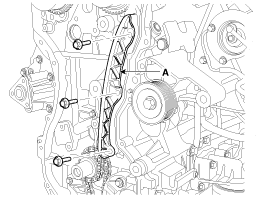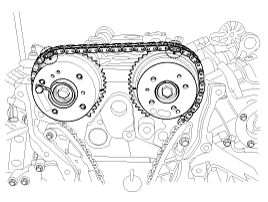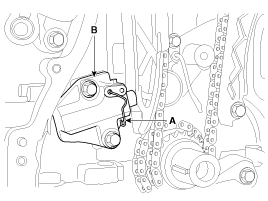 Hyundai Santa Fe: Timing Chain. Repair procedures
Hyundai Santa Fe: Timing Chain. Repair procedures
Removal
| 1. |
Remove the cylinder head cover.
|
| 2. |
Turn the crankshaft pulley and align its groove with
the timing mark of the timing chain cover to set the piston of No.1
cylinder to the top dead center on compression stroke.
|
| 3. |
Remove the timing chain cover.
|
| 4. |
Make sure that the key (A) of crankshaft is aligned
with the mating surface of main bearing cap. As a result of this, the
piston of No.1 cylinder is placed at the top dead center on compression
stroke.
|
| 5. |
Release the ratchet by pulling the link down using
a thin rod. Compress the piston and then insert a stopper pin (A) into
the hole on the ratchet to hold the compressed piston. Remove the timing
chain tensioner (B).
|
| 6. |
Remove the timing chain tensioner arm (A).
|
| 7. |
Remove the timing chain (A).
|
| 8. |
Remove the timing chain guide (A).
|
| 9. |
Remove the timing chain oil jet (A) and the crankshaft
chain sprocket (B).
|
| 10. |
Remove the balance shaft chain.
|
Inspection
Sprockets, Hydraulic Tensioner, Chain Guide, Tensioner Arm, Timing Chain
| 1. |
Check the CVVT sprocket, crankshaft sprocket teeth
for abnormal wear, cracks or damage. Replace if necessary.
|
| 2. |
Check a contact surface of the chain tensioner arm
and guide for abnormal wear, cracks or damage.
Replace if necessary.
|
| 3. |
Check the hydraulic tensioner for its piston stroke
and ratchet operation. Replace if necessary.
|
| 4. |
Check the timing chain for its elongation, abnormal
wear or damage. Replace if necessary.
|
Installation
| 1. |
Install the balance shaft chain.
|
| 2. |
Install the crankshaft chain sprocket (B) and the
timing chain oil jet (A).
|
| 3. |
Set the crankshaft so that the key (A) of crankshaft
will be aligned with the mating surface of main bearing cap. Put the
intake and exhaust camshaft assembly so that the TDC marks (B) of the
intake and exhaust CVVT sprockets will be aligned with the top surface
of cylinder head. As a result of this, the piston of No.1 cylinder is
placed at the top dead center on compression stroke.
|
| 4. |
Install the timing chain guide (A).
|
| 5. |
Install the timing chain. To install the timing chain
with no slack between each shaft (cam, crank), follow the below procedure.
Crankshaft sprocket (A) → Timing chain guide (B)
→ Intake CVVT sprocket (C) → Exhaust CVVT sprocket (D).
|
| 6. |
Install the timing chain tensioner arm (A).
|
| 7. |
Install the timing chain auto tensioner (B) and remove
the stopper pin (A).
|
| 8. |
After rotating crankshaft 2 revolutions in regular
direction (clockwise viewed from front), confirm that the TDC marks
(A) on the intake and exhaust CVVT sprockets aligned with the top surface
of cylinder head.
|
| 9. |
Install the timing chain cover.
|
| 10. |
Install cylinder head cover.
|
| 11. |
Add all the necessary fluids and check for leaks.
Connect GDS. Check for codes, note, and clear. Recheck.
|
 Timing Chain. Components and Components Location
Timing Chain. Components and Components Location
Components 1. Timing chain 2. Timing chain guide 3. Timing chain tension arm 4. Timing chain tension 5. Balance shaft chain 6. Balance shaft chain tension arm 7. Balance shaft chain tension 8. Balance ...
See also:
Rail Pressure Sensor (RPS). Specifications
Specification ...
Description and Operation
Description Back view camera will activate when the backup light is ON with the ignition switch ON and the shift lever in the R position. This system is a supplemental system that shows behind the vehicle ...
Head Lamps. Description and Operation
HID Head Lamp 1. Bulb (1) Elements Xenon gas: Xenon gas activates the initial reaction for rapid illuminating. Molybdenum electrode: anode arcing Metal halide salts: color composing component (2) Lightening ...















